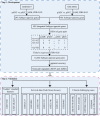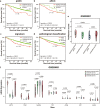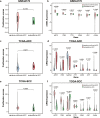A qualitative transcriptional signature for the histological reclassification of lung squamous cell carcinomas and adenocarcinomas
- PMID: 31752667
- PMCID: PMC6868745
- DOI: 10.1186/s12864-019-6086-2
A qualitative transcriptional signature for the histological reclassification of lung squamous cell carcinomas and adenocarcinomas
Abstract
Background: Targeted therapy for non-small cell lung cancer is histology dependent. However, histological classification by routine pathological assessment with hematoxylin-eosin staining and immunostaining for poorly differentiated tumors, particularly those from small biopsies, is still challenging. Additionally, the effectiveness of immunomarkers is limited by technical inconsistencies of immunostaining and lack of standardization for staining interpretation.
Results: Using gene expression profiles of pathologically-determined lung adenocarcinomas and squamous cell carcinomas, denoted as pADC and pSCC respectively, we developed a qualitative transcriptional signature, based on the within-sample relative gene expression orderings (REOs) of gene pairs, to distinguish ADC from SCC. The signature consists of two genes, KRT5 and AGR2, which has the stable REO pattern of KRT5 > AGR2 in pSCC and KRT5 < AGR2 in pADC. In the two test datasets with relative unambiguous NSCLC types, the apparent accuracy of the signature were 94.44 and 98.41%, respectively. In the other integrated dataset for frozen tissues, the signature reclassified 4.22% of the 805 pADC patients as SCC and 12% of the 125 pSCC patients as ADC. Similar results were observed in the clinical challenging cases, including FFPE specimens, mixed tumors, small biopsy specimens and poorly differentiated specimens. The survival analyses showed that the pADC patients reclassified as SCC had significantly shorter overall survival than the signature-confirmed pADC patients (log-rank p = 0.0123, HR = 1.89), consisting with the knowledge that SCC patients suffer poor prognoses than ADC patients. The proliferative activity, subtype-specific marker genes and consensus clustering analyses also supported the correctness of our signature.
Conclusions: The non-subjective qualitative REOs signature could effectively distinguish ADC from SCC, which would be an auxiliary test for the pathological assessment of the ambiguous cases.
Keywords: Histological subtype; Non-small cell lung cancer; Pathological assessment; Qualitative transcriptional signature; Relative gene expression orderings.
Conflict of interest statement
The authors declare that they have no competing interests.
Figures





Similar articles
-
Hierarchical identification of a transcriptional panel for the histological diagnosis of lung neuroendocrine tumors.Front Genet. 2022 Aug 29;13:944167. doi: 10.3389/fgene.2022.944167. eCollection 2022. Front Genet. 2022. PMID: 36105102 Free PMC article.
-
A combined gene expression tool for parallel histological prediction and gene fusion detection in non-small cell lung cancer.Sci Rep. 2019 Mar 26;9(1):5207. doi: 10.1038/s41598-019-41585-4. Sci Rep. 2019. PMID: 30914778 Free PMC article. Clinical Trial.
-
The value of AGR2 and KRT5 as an immunomarker combination in distinguishing lung squamous cell carcinoma from adenocarcinoma.Am J Transl Res. 2021 May 15;13(5):4464-4476. eCollection 2021. Am J Transl Res. 2021. PMID: 34150027 Free PMC article.
-
Are adenosquamous lung carcinomas a simple mix of adenocarcinomas and squamous cell carcinomas, or more complex at the molecular level?Lung Cancer. 2010 Apr;68(1):1-9. doi: 10.1016/j.lungcan.2009.11.001. Epub 2009 Dec 8. Lung Cancer. 2010. PMID: 20004040 Review.
-
Genome analyses identify the genetic modification of lung cancer subtypes.Semin Cancer Biol. 2017 Feb;42:20-30. doi: 10.1016/j.semcancer.2016.11.005. Epub 2016 Nov 11. Semin Cancer Biol. 2017. PMID: 27845189 Review.
Cited by
-
An 8-Gene Signature for Classifying Major Subtypes of Non-Small-Cell Lung Cancer.Cancer Inform. 2022 Jun 14;21:11769351221100718. doi: 10.1177/11769351221100718. eCollection 2022. Cancer Inform. 2022. PMID: 35722224 Free PMC article.
-
Hierarchical identification of a transcriptional panel for the histological diagnosis of lung neuroendocrine tumors.Front Genet. 2022 Aug 29;13:944167. doi: 10.3389/fgene.2022.944167. eCollection 2022. Front Genet. 2022. PMID: 36105102 Free PMC article.
-
Comprehensive molecular characterization of lung tumors implicates AKT and MYC signaling in adenocarcinoma to squamous cell transdifferentiation.J Hematol Oncol. 2021 Oct 16;14(1):170. doi: 10.1186/s13045-021-01186-z. J Hematol Oncol. 2021. PMID: 34656143 Free PMC article.
-
A Simple Method for Robust and Accurate Intrinsic Subtyping of Breast Cancer.Cancer Inform. 2023 Mar 25;22:11769351231159893. doi: 10.1177/11769351231159893. eCollection 2023. Cancer Inform. 2023. PMID: 37008073 Free PMC article.
-
Identification of transcriptional subtypes in lung adenocarcinoma and squamous cell carcinoma through integrative analysis of microarray and RNA sequencing data.Sci Rep. 2021 Apr 22;11(1):8709. doi: 10.1038/s41598-021-88209-4. Sci Rep. 2021. PMID: 33888829 Free PMC article.
References
-
- Girard L, Rodriguez-Canales J, Behrens C, Thompson DM, Botros IW, Tang H, Xie Y, Rekhtman N, Travis WD, Wistuba II, et al. An expression signature as an aid to the histologic classification of non-small cell lung cancer. Clin Cancer Res. 2016;22(19):4880–4889. doi: 10.1158/1078-0432.CCR-15-2900. - DOI - PMC - PubMed
-
- Montezuma D, Azevedo R, Lopes P, Vieira R, Cunha AL, Henrique R. A panel of four immunohistochemical markers (CK7, CK20, TTF-1, and p63) allows accurate diagnosis of primary and metastatic lung carcinoma on biopsy specimens. Virchows Arch. 2013;463(6):749–754. doi: 10.1007/s00428-013-1488-z. - DOI - PubMed
MeSH terms
Substances
Grants and funding
- 61701143/National Natural Science Foundation of China
- 81372213/National Natural Science Foundation of China
- 81572935/National Natural Science Foundation of China
- 2016Y9044/the Joint Scientific and Technology Innovation Fund of Fujian Province
- 2017JCZX48/the Fundamental Research Funds for the Provincial Universities
LinkOut - more resources
Full Text Sources
Medical
Research Materials
Miscellaneous

